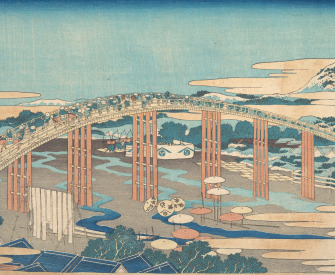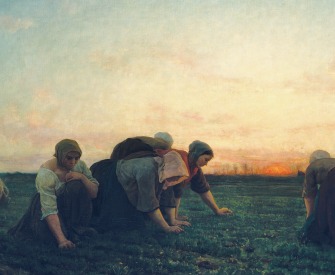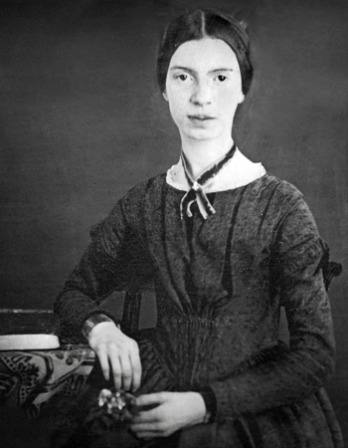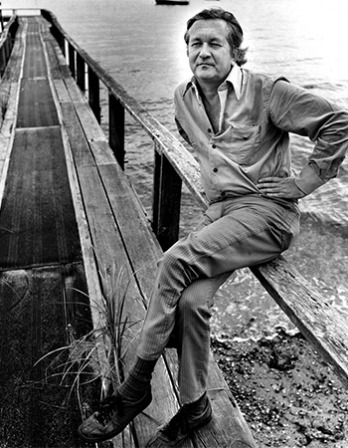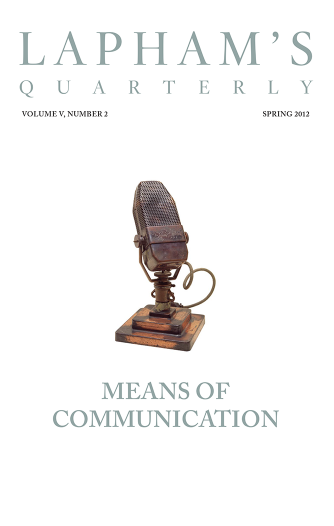For everything there is a season, and a time for every matter under heaven.
—Book of Ecclesiastes, 250 BCReelin’ in the Years
Can there be a more terrifying revelation than the present moment? Reconsidering Virginia Woolf’s time-warped novel Orlando.
By Colin Dickey

Portrait of Benedikt von Hertenstein, by Hans Holbein the Younger, 1517. Metropolitan Museum of Art, Rodgers Fund.
We meet Orlando as a boy of sixteen years, introduced during the waning days of Queen Elizabeth’s reign. The bored son of nobility, Orlando is favored as the queen’s pet, fêted with privilege and riches, before he falls in love with a beautiful Russian princess during the great frost of 1608. After watching her boat sail away the morning the Thames thaws, Orlando loses nearly a century idly reading and writing in his ancestral estate before being sent to Istanbul as an ambassador; there, without explanation or histrionics, Orlando falls asleep for one week and wakes up a woman. Ultimately she returns to England in time to hold court with Alexander Pope and eventually marry, witnessing along the way the birth of the nineteenth and twentieth centuries. By the end of Orlando: A Biography, Virginia Woolf’s account of over three centuries in the life of an apparent immortal, Orlando is in her midthirties, and the novel ends on the day of its initial publication: October 11, 1928.
Despite being subtitled “A Biography,” Orlando is very much a novel, and as with much of Woolf’s earlier work—Jacob’s Room (1922), Mrs. Dalloway (1925), To The Lighthouse (1927)—it is concerned with the disparity between the objective passage of time and subjective lived experience. “An hour, once it lodges in the queer element of the human spirit, may be stretched to fifty or a hundred times its clock length,” the chatty narrator notes, “on the other hand, an hour may be accurately represented on the timepiece of the mind by one second. This extraordinary discrepancy between time on the clock and time in the mind is less known than it should be and deserves fuller investigation.”
Of course, by 1928 there already had been plenty of “fuller investigation” into this discrepancy. In 1889, philosopher
Henri Bergson had proposed the concept of durée: an experience of time that was subjective rather than chronological. “I saw, to my great astonishment,” Bergson later wrote to William James, “that scientific time does not endure…that positive science consists essentially in the elimination of duration.”
In the wake of the Great War, theologian Paul Tillich invoked the Greek term kairos to diagnose the peculiar mood of the day. In Greek rhetoric, kairos can signify discerning and seizing the perfect moment for a rebuttal to an opponent’s argument. The word was in turn used by Saint Paul throughout his epistles, referring to the precise moment when the Lord would return—time redeemed, time fulfilled, the past recaptured. Kairos, Tillich explained, expressed “the feeling of many people in central Europe after the First World War that a moment of history had appeared which was pregnant with a new understanding of the meaning of history and life…Its original meaning—the right time, the time in which something can be done—must be contrasted with chronos, measured time or clock time. The former is qualitative, the latter quantitative.”
This need for a method to oppose chronological time—quantitative, measured, and objective—was overwhelming: philosophers and writers drew on science and religion in search of ways to describe the time between moments, and the great writers of modernism took these ideas and embedded them in literary masterpieces, teasing out articulations of time based not on objective measurements but on subjective experience. A rough beast slouched forth from the horrors of the Somme; soldiers limping home were trapped in the terror of their own recent memories, as though time had stopped forever. Philosophers and industrialists gazed so far into the future that the present evaporated before them. It was clear to anyone paying attention that a single, monolithic definition of time would not provide an acceptable clock.
The tension between these two times was a singular preoccupation, if not the preoccupation,of modernist literature. Invariably, it was the time on the clock that was seen as the oppressor: chronological time was seen as artificial, contorting experience into an arbitrary, quantifiable landscape. Already in Mrs. Dalloway, Woolf had written of the authoritarian power of the clock:
Shredding and slicing, dividing and subdividing, the clocks of Harley Street nibbled at the June day, counseled submission, upheld authority, and pointed out in chorus the supreme advantages of a sense of proportion, until the mound of time was so far diminished that a commercial clock, suspended above a shop in Oxford Street, announced, genially and fraternally, as if it were a pleasure to Messrs. Rigby and Lowndes to give the information gratis, that it was half-past one.
Mrs. Dalloway is a novel that, like Ulysses, takes place over a single day, the ordinary diurnal rhythm played against the seemingly infinite unspooling of memory. Its structure poses memory as a counterbalance to the sense of time as purely a matter of minutes and seconds, substituting kairos for the regular passage of hours. What matters is the pregnant pause, the story that elapses between the tick and the tock. The exemplars of modernist literature had all adhered to this clock, most famously Marcel Proust’s three-thousand page In Search of Lost Time, a book contained within two bites of a madeleine.
But what if that pregnant pause were not a lifetime of memories, but rather an entire span of centuries? With Orlando, time of the mind becomes historical; Orlando’s vampiric longevity is a challenge to readers to think of the self as constructed over hundreds of years. Woolf doesn’t wish to explore the tension between chronos and kairos; she would rather annihilate it. “Yet I am now & then haunted by some semi mystic very profound life of a woman, which shall all be told on one occasion,” she wrote in her diary in the fall of 1926, “& time shall be utterly obliterated; future shall somehow blossom out of the past. One incident—say the fall of a flower—might contain it. My theory being that the actual event practically does not exist—nor time either.”
Orlando was the product, first and foremost, of Woolf’s relationship with Vita Sackville-West. Sackville-West was a novelist who moved in the same circles as Woolf; perhaps more intriguingly, she was nobility, the daughter of the third Baron Sackville, and she carried with her an aristocratic flair that captivated Woolf. Shortly after their first meeting, Woolf wrote in her diary, “Snob as I am, I trace her passions 500 years back, & they become romantic to me, like old yellow wine.” Their friendship flowered and by the end of 1925 had become sexual, tolerated by both of their husbands. (Sackville-West’s husband, Harold Nicolson, himself had homosexual affairs.) Then, in the fall of 1927, Woolf realized that Sackville-West could embody the “semi mystic very profound life of a woman” that had been haunting her; and on October 5 the idea for the new book crystallized in her, “a biography beginning in the year 1500 & continuing to the present day, called Orlando: Vita; only with a change about from one sex to another.”
Orlando has long had a towering, and very much deserved, reputation in the LGBT community; it was published the same year Radclyffe Hall’s controversial The Well of Loneliness, depicting lesbianism as a tragic curse, became a bestseller. Woolf’s creation of a figure who effortlessly changes sex casually upends any notion that biological sex is related to gender or orientation—even the notion that biological sex is fixed and stable at all.
Sackville-West’s son Nigel Nicolson would later call Orlando “the longest and most charming love letter in literature,” and whether or not it began as a private missive for Vita, it’s also clearly much, much more, and early on in its genesis it began to exceed whatever initial idea Woolf had for it. “For the truth is I feel the need of an escapade after these serious poetic experimental books whose form is always so closely considered,” she wrote in March 1927. “I want to kick up my heels & be off. I want to embody all those innumerable little ideas & tiny stories which flash into my mind at all seasons. I think it will be great fun to write; & it will rest my head before starting the very serious, mystical poetical work which I want to come next.”
And it is indeed fun, with an exuberance that Woolf rarely displayed. Yet Orlando is not unserious—it’s a laboratory of ideas, filled with a hundred “little ideas & tiny stories” that reflect less a unified biography than they do an encyclopedia of living. If her other novels are obsessed with memory and loss, trauma and regret, Orlando is obsessed more firmly with the question of time: what it is and how it passes, and how its passing is marked by its participants. What makes Orlando different is an avoidance of exploding a single moment, grasping instead the entire arc of history. Memory here is not a faded photograph but a library in disarray.
The tragedy of Woolf’s other protagonists was their inability to reconcile time on the clock with time of the mind, particularly in a landscape where the gears of modernity ground up anyone who stood in the way—an irrevocable machine moving ever forward no matter how long the inner landscape might want to linger in the moment. The death of Jacob Flanders during the Great War occurs offstage in Jacob’s Room; the suicide of the shell-shocked Septimus Smith is overheard as party chatter in Mrs. Dalloway; and the deaths in To the Lighthouse occur as bracketed asides in the rapidly compressed middle section, “Time Passes”—all of these suggest the way modernity stops for no one and never looks back.
With Orlando, the narrator begins to describe how the passage of time works on the young man (“He saw the beech trees turn golden and the young ferns unfurl; he saw the moon sickle and then circular”), then breaks off: “but probably the reader can imagine the passage which should follow and how every tree and plant in the neighborhood is described first green, then golden; how moons rise and suns set; how spring follows winter and autumn summer,” and so forth. Woolf takes a casual jab at her previous masterworks: the narrator concludes that one might just as easily summarize the passage of time with “the simple statement that ‘time passed’ (here the exact amount could be indicated in brackets) and nothing whatever happened.”
Instead, Woolf decides, life need not be described solely as moving irrevocably forward, to be accompanied by exhaustion and regret. Normally in Woolf’s fiction marriage is a thing to be feared or, at best, endured. But here, love, engagement, and marriage are just another series of liminal transitions in which temporality is wildly in flux. After breaking her ankle, Orlando lies defeated in a bog (“I have sought happiness through many ages and not found it; fame and missed it; love and not known it; life—and behold, death is better,” she laments). On the verge of embracing solitude, she’s startled by a stranger’s approach: “Towering dark against the yellow-slashed sky of dawn, with the plovers rising and falling about him, she saw a man on horseback. He started. The horse stopped.” After a two-line courtship (“Madam…you’re hurt!” “I’m dead, sir!”), the two are engaged in a matter of minutes; only later does she learn his name, Marmaduke Bonthrop Shelmerdine.
For the first time Woolf found a language to portray marriage as a headlong rush; the two characters spend weeks languidly lying amid the foliage before suddenly remembering it’s their wedding day, galloping toward the church as the congregation appears as if conjured by magic:
Bells were rung. People were summoned. At length there was Mr. Dupper catching at the ends of his white tie and asking where was the prayer book. And they thrust Queen Mary’s prayer book in his hands and he searched hastily fluttering the pages, and said, “Marmaduke Bonthrop Shelmerdine, and Lady Orlando, kneel down”; and they knelt down, and now they were bright and now they were dark as the light and shadow came flying helter skelter through the painted windows…All was movement and confusion.
If all this sounds as though Woolf’s characters are the passive victims of time’s movements, the broader reach of the novel suggests the opposite. Just as time can affect the human mind, “the mind of man, moreover, works with equal strangeness upon the body of time.” Throughout Orlando, characters make and are made by time—particularly the narrator, whose voice modulates throughout the novel. The tempo of each chapter is unique; and every section bears a different time signature. Early sentences are stuffed with extraneous clauses (“For though these are not matters on which a biographer can profitably enlarge, it is plain enough to those who have done a reader’s part in making up from bare hints dropped here and there the whole boundary and circumference of a living person,” begins one nearly page-long sentence), whereas passages from the twentieth century are a slapdash of fragments and chaos (“Nothing could be seen whole or read from start to finish. What was seen begun—like two friends starting to meet each other across the street—was never seen ended. After twenty minutes the body and mind were like scraps of torn paper tumbling from a sack…”). How we experience time is very much coeval with how we use language, and what Orlando makes plain is that we are constantly in the process of inventing time—through our technologies, our words, and our actions—much more so than passively living in it.
It was precisely because of her belief that time was created through the act of living that Woolf took such a dim view of the possibilities of traditional biography. The same year the novel was published, she had written, in an essay called “The Art of Biography,” that “the majority of Victorian biographies are like the wax figures now preserved in Westminster Abbey, that were carried in funeral processions through the street—effigies that have only a smooth superficial likeness to the body in the coffin.” Orlando: A Biography became a way to critique the genre of biography, specifically its slavish adherence to the chronological arc of a life. It cannot be denied, the narrator notes at one point:
that the most successful practitioners of the art of life, often unknown people by the way, somehow contrive to synchronize the sixty or seventy different times which beat simultaneously in every normal human system so that when eleven strikes, all the rest chime in unison, and the present is neither a violent disruption nor completely forgotten in the past. Of them we can justly say that they live precisely the sixty-eight or seventy-two years allotted them on the tombstone. Of the rest, some we know to be dead, though they walk among us; some are not yet born, though they go through the forms of life; others are hundreds of years old though they call themselves thirty-six.
“The true length of a person’s life, whatever the Dictionary of National Biography may say,” the narrator concludes, “is always a matter of dispute.” Biography, Woolf believed, must go beyond merely reportage, as she explained in her essay: “Since we live in an age when a thousand cameras are pointed, by newspapers, letters, and diaries, at every character from every angle, [the biographer] must be prepared to admit contradictory versions of the same face. Biography will enlarge its scope by hanging up looking glasses at odd corners. And yet from all this diversity it will bring out, not a riot of confusion, but a richer unity.”
By piling centuries upon the same figure, Woolf sought to build a bridge to the past, one that cut against the grain of the contemporary landscape. Futurists and industrialists could trumpet the virtues of the now, but this boosterism hid a more terrifying reality: the traumatic wound of World War I, a violence that had opened a rift between present and past. As with many other works from the 1920s, there is an overwhelming emphasis on the recent horror and its aftermath. The most terrifying aspect of this all, perhaps, was the fact that modernity was so stubbornly bound in the now. For even if we have broken from the past, these works tell us, we remain bound to it, a conjoined twin who has woken in the night to discover his brother is dead. The time of modernism is always one of postapocalypse, its questions always about how to go on after the end, how to shore up the ruins.

Bison at Maxwell Game Preserve, Roxbury, Kansas, December, by Terry Evans, 1981. Chromogenic print. © Terry Evans, courtesy of the artist and Yancey Richardson.
“For what more terrifying revelation can there be,” our narrator wonders, “than that it is the present moment?” The solution was not to go boldly ever forward, leaving the past behind us, nor simply to mourn and forget the past, but rather to live in the past as well as the now: “That we survive the shock at all is only possible because the past shelters us on one side, the future on another.” It’s in restructuring our relationship to history, to lineage and the evolution of a landscape, Orlando seems to promise, that we can begin to imagine a future.
Of Woolf’s great novels, Orlando is one of the few that revolves around the protagonist’s life, not his/her death, as though she had finally discovered the secret to avoiding tragedy. Woolf, of course, isn’t advocating immortality; rather, Orlando suggests that to really master time, one must inhabit history with the same intensity as one does one’s own past, that the art of living requires seizing whole centuries with the same gusto as one seizes the day.
The rules of Orlando’s immortal physics aren’t explained, nor do they follow any obvious logic. (Director Sally Potter made an attempt in her 1992 film adaptation, rendering what was delightfully ambiguous in the novel overbearingly symbolic and obvious). Orlando is sixteen at the book’s beginning near the end of the sixteenth century; he reaches his early thirties in the seventeenth century, and then remains around that age as he changes gender, aging only a few more years before the novel’s end in 1928. Lest anyone cling to the notion that there’s a chronological order waiting to be teased out, the novel proliferates with winks and nods, including several photographs dated from the eighteenth and early nineteenth centuries. Time in Orlando is all affect—it is a frock that can be changed at will. It is nothing other than the sum of its parts—its technologies, its politics, its disasters—and as such, any given age can be adopted or discarded.
The solution to reconciling time on the clock with time of the mind is a cosmic detachment, a god’s-eye view in which the passage of eons is as unserious as the changing of fashion. This preternatural embodiment of the past not only offers the means to understand the world, it also seems to necessitate a withdrawal from it. While the other major protagonists of Woolf’s fiction were all, one way or another, crushed by history, Orlando, given a cosmoslike understanding of the passage of time, maintains a serenity toward events. If in Orlando Woolf had finally created a character who could transcend chronos entirely, the novel by its end cannot help but pose the question: is it worth it?
As any vampire will tell you, immortality isn’t without its price. Watching the ages fly by, Orlando is detached, without allegiance to any century or its petty concerns. Loneliness is a constant preoccupation of Woolf’s ostensible immortal, who seems capable of connecting with the world and others only in brief flashes, moments of intensity that dissipate in an instant. The loneliness of Clarissa Dalloway or Mrs. Ramsay is a loneliness of melancholy and regret, of looking back across the space of years and taking stock of a life that has passed by too soon. Having loved and lost, their recollections are at least bittersweet. Regret is quite the opposite for Orlando, having spent centuries trying and failing to carry out E.M. Forster’s dictum to “only connect.” Her loves are wild with passion, but seem to leave no trace, and by the novel’s end she is left occasionally wounded, but always without the pleasure of a scar.
Reading Orlando alongside the rest of Woolf’s novels, it’s clear that it’s precisely the tension between these two modes of time, and the exquisite pain that results from their friction, that is the very stuff that drums us alive. Orlando ends not with the death of its protagonist—who is perhaps alive and well, living somewhere in London today—but simply because at some point there’s nothing left to add. Woolf may simply have been tired of writing her, or assumed her audience might be tired of reading about her, and Orlando’s life is closed with a grand ellipsis as she sees an airplane streak across the sky. (“‘It is the goose!’ Orlando cried. ‘The wild goose…’”) Freed from the terror of mortality, time loses its teeth.

